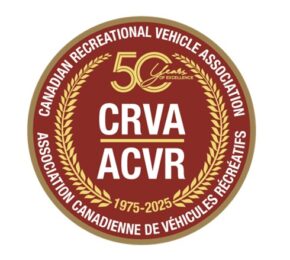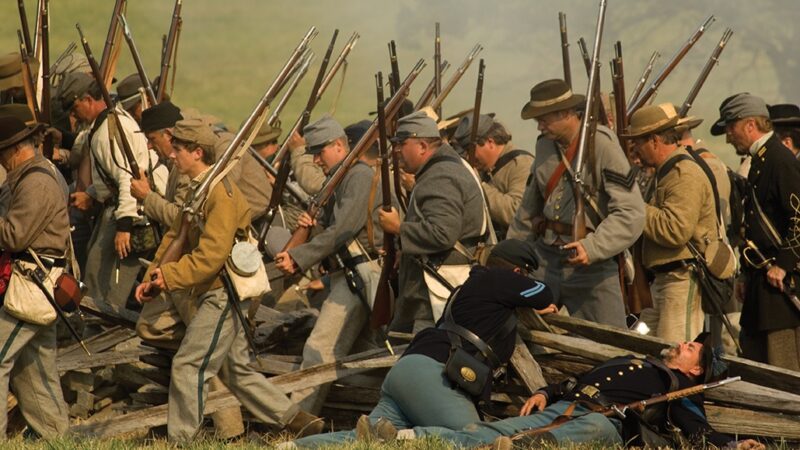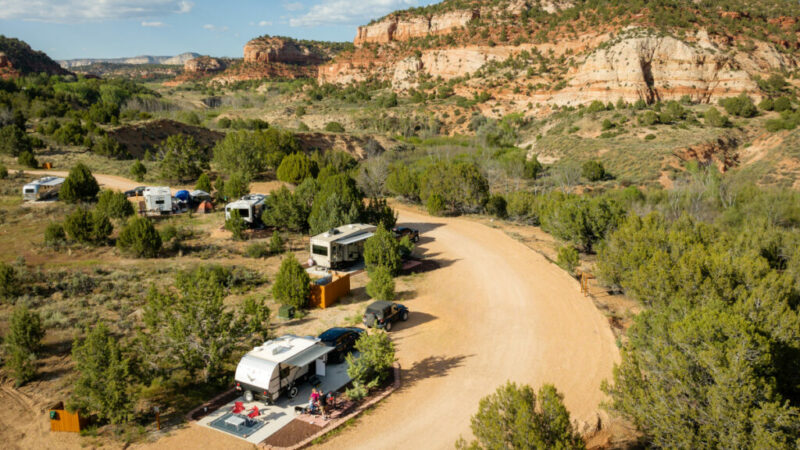St. Jacobs to Stratford
A Southern Ontario Gastronomic Adventure.
By Phyllis Hinz & Lamont Mackay
Some of our best experiences are off the main highways. One of our favourite side trips in southwestern Ontario is to visit St. Jacobs and Stratford, and travel the back roads between them. As separate destinations, both communities are worth a visit any time of the year. Combined, they’re a must-do on anyone’s travel calendar.
St. Jacobs is a place where the past and present mingle, where motorhomes and cars share the roads and parking lots with horse drawn vehicles. The village has 1,400 inhabitants but 1.5 million people visit annually, lured by glass blowers, potters, weavers, jewelers, broom makers, blacksmiths, painters and quilters. Visitors stroll along the streets and explore the shops for furniture, clothing, baked goods, crafts, angels and antiques. They savor the famous Waterloo County cuisine and embrace the rural charm of the Old Order Mennonites.
The Mennonites first settled in the St. Jacobs area in the early 1800s. About 10 percent of the Mennonite population consists of Conservative or Old Order Mennonites. The horse and buggy is their means of transportation. For the most part, their homes are without electricity, plumbing or telephones. The men and boys wear dark or light blue shirts and black broadbrimmed or straw hats, depending on the season. The women wear longskirted dresses with high necklines, black boots and bonnets.
The Moderate Mennonites make up 14 percent of the Mennonite population. They mix traditional ways with modem technology and conveniences. They drive black cars, often with the chrome painted black, and generally have electricity, plumbing and telephones in their homes. The Old Order and Moderate Mennonites share rural churches, called meetinghouses, by attending on alternate Sundays. The meetinghouses are plain, simple and unadorned so the structure does not distract from religious life. The Progressive Mennonites are the largest group in the area. They blend in with Canada’s 21st century society. The Visitor Centre, beside the post office, exhibits the unique aspects of Mennonite history, lifestyle and beliefs.
St. Jacobs is a place where modem commercialism co-exists with the simplicity of the Old Order lifestyle. We regularly return to experience its blend of old and new. We also return for the food.
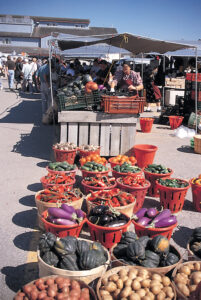
The Mennonite and German influence is evident everywhere here on restaurant menus. Farmer’s sausage, spare ribs, pigtails, sauerkraut, mashed potatoes, schnitzel, hearty soups and fresh baking are always available, and inevitably delicious.
Buildings reflect the village’s history. Benjamin’s Restaurant and Inn was once a stagecoach stop. Built in 1852, the original hand-hewn beams and substantial brick and mortar remain, with a few modem touches. The oldest home in the village, at 1401 King Street North, is a retail store called Baby’s at Home. During reconstruction, of the 1857 Georgian building, the owners discovered a child’s shoe buried in the brick wall. Placed there as a good luck charm, it still resides between the bricks, open to public view.
The Home Hardware Store is a part of the modern history of St. Jacobs. The foundation store for the national chain offers every household convenience as well as old-fashioned washboards.
The St. Jacobs Schoolhouse Theater presents music, drama and dance in an intimate 1867 schoolhouse. The Church Theatre, a former church building, provides excellent acoustics for musical works.
Horse-drawn trolleys carry passengers between downtown and the St. Jacobs Farmers’ Market and Flea Market and the Waterloo County Farmer’s Market as well as the St. Jacobs Factory Outlet Mall. The Outlet Mall is open seven days a week and is within walking distance of the markets. More than 30 stores offer clothing, footwear, home accessories and specialty foods.
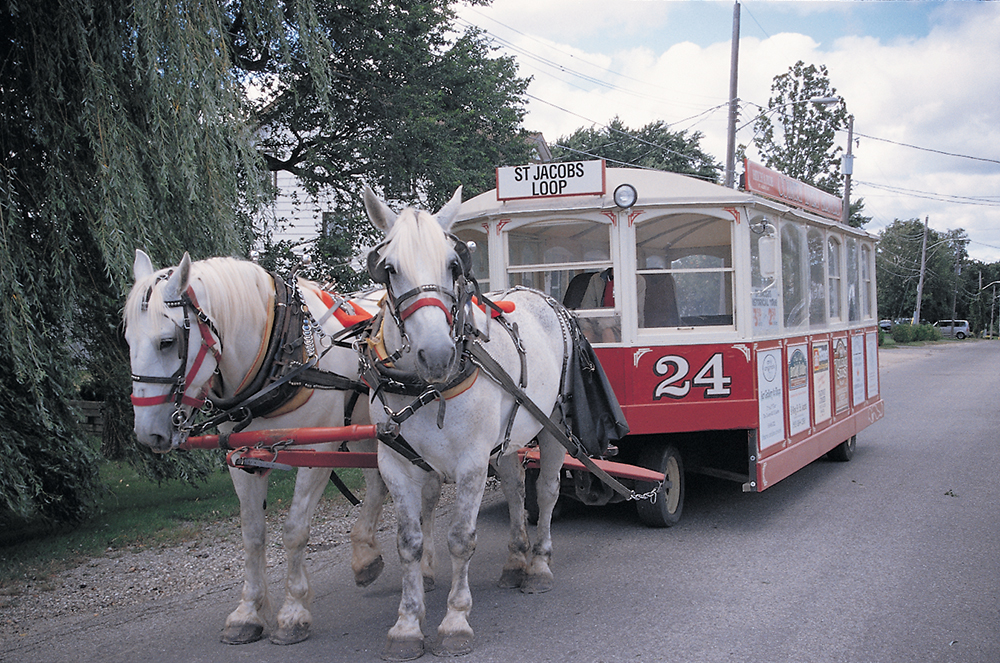
Both markets are open two to three days a week and have more than 600 vendor stalls inside arid outdoors. They offer a huge selection of regional and international foods including fresh and smoked meats, cheese, fruit, vegetables, homemade pies and pastries. Farmers arrive early in the morning to sell their produce. Many offer garden vegetables from the backs of buggies while their horses stand waiting at a nearby hitching post. Fresh baking and flowers fill the morning air with the smells and colors of the season. Local crafts, clothing and house wares add to the selection.
The two markets are five minutes from St. Jacobs by motorhome, and we’re told 29 minutes by horse. Along the route out of the village, many of the fields are worked by horsepower. In the distance, a maple syrup shack sits in a sugar bush. A homemade sign on a gatepost reads “Summer Sausage. Maple syrup. Pups. No Sunday Sales.”
St. Jacobs is extremely RV friendly. Large lots are available downtown as well as at the outlet mall and markets. Overnight dry-camping is available in a paved, well lit lot at the outlet mall.
Our back roads tour from St. Jacobs to Stratford begins north of the markets at Wagner’s Corners, the intersection of Kings Street North and Lobsinger Line or Regional Road 15.
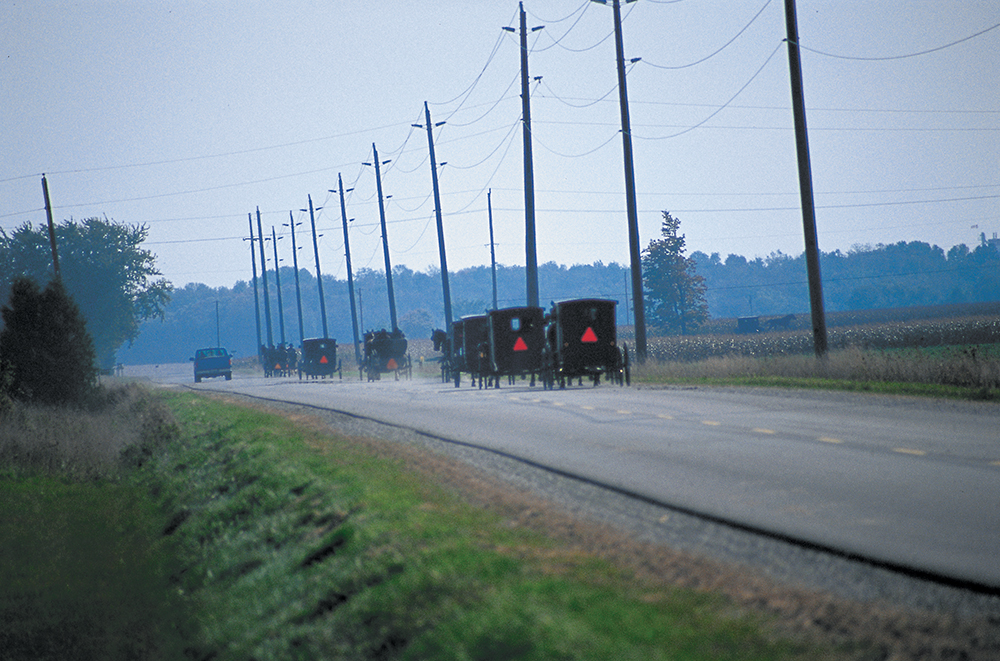
Gently rolling farm fields and orchards are immediately evident. Road signs depict areas where Mennonite buggies are a part of regular traffic. Slow moving, Mennonite vehicles are designated with a fluorescent red triangle at the rear. Under normal conditions these horse-drawn vehicles keep to the gravel shoulders. Automobile and RV drivers are expected to reduce speed when passing the horses. Many long lanes leading to farmhouses are without hydro or telephone poles, evidence of an Old Order farm, Signs at the ends of laneways advertise fruit, fresh pies, brown eggs, handcrafted quilts, maple syrup and Mennonite furniture and wood products for sale.
There is no reason to be hungry on our back roads tour. Every small town has its specialty. The first stop is Heidelberg, home of the Heidelberg Restaurant and Brew Pub. Spare ribs, pork hocks, pigtails and sauerkraut are on the menu. Shuffleboard competitions and sing-alongs are regular happenings.
Leaving the Heidelberg Restaurant we tum south on Kressler Road or Regional Road 16. There is a small Mennonite School on the right. We always watch for herons in the creek. We do not follow Regional Road 16 when it veers left at the David Fisher Residence. Instead, we continue straight ahead and turn right on the Weimar Line or Regional Road 14 to Bamberg. We enjoy the old stone houses and long lanes leading to hidden country estates. At the red flashing light in Bamberg we turn south (left) on Regional Road 14 or Moser-Young Road. At the T intersection we go east (left) on Gerber Road or Regional Road 12. On one particular trip we stopped while a farmer’s ducks crossed the road. From here, we soon see the church spire in St. Agatha, a landmark that stands tall in the distance.
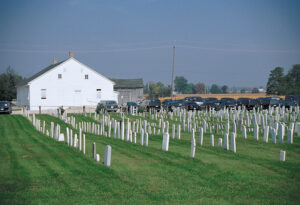
cemetary functions as a community
meeting place.
In St. Agatha an historic 1854 inn houses Angie’s, a family-style restaurant. Across the street, Kennedy’s tavern has an Irish flair that specializes in dressed rolled ribs. The assortment of smoked pork chops, sausage and bacon in the local St. Agatha Meat Market down the street make a stop there worthwhile.
From St. Agatha we continue south on Regional Road 12 to Petersburg. The Blue Moon Hotel is a designated heritage building and yet another famous food and watering spot. At the Blue Moon comer we tum west (right) on Snyder’s Road or Regional Road 6. We enter Baden by curving to the right off the main road.
The highlight in Baden is Castle Kilbride. This mansion was once the home of James Livingston, a 19th century entrepreneur, politician, and king of the flax industry. Built in 1877 and now a national historic site, Castle Kilbride provides a journey into the lavish Victorian era. The ceiling and wall paintings are the primary reason for the Castle’s designation as a National Historic Site. The paintings reflect the Victorian love of extravagance and variety. The main hall is decorated with classic Corinthian columns, a statue set into an alcove and intricate vases. At first glance these things seem perfectly real but in fact they are part of a three-dimensional painting technique. Thirty-two different colors appear in the classic motifs in the library. E.J.’ s across the street is a popular pub and the Baden Emporium is always worth a visit.
We drive’ south out of Baden on Foundry Street or Regional Road 51 to Highway 7 /8 and turn west toward Stratford. Within minutes a side trip can be made into New Hamburg. This quiet town along the Nith River is the home of the Annual Mennonite Relief Sale and Quilt Auction held the last Saturday of May.
Continuing west on Highway 7 /8 we approach Shakespeare, the last small village before Stratford. Shakespeare is the place for antique shopping whether it be in a cluttered, jumbled shop or high-end emporium. Silver. China. Quilts. Furniture. Shakespeare is also the spot for a good cup of tea.
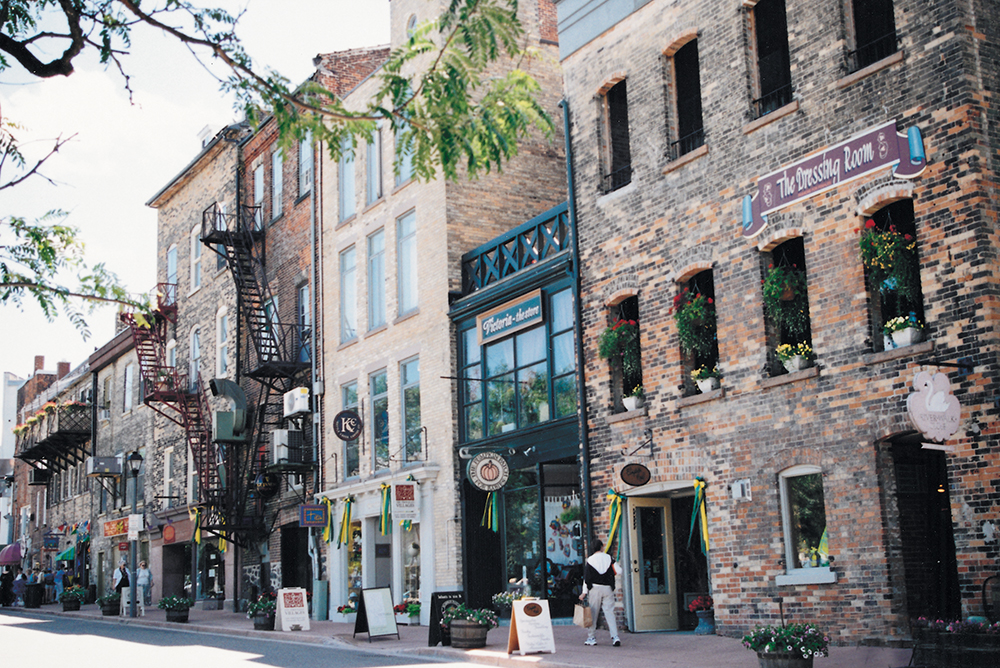
Stratford, just minutes west of Shakespeare, is a city with something for everyone. In 1997 it was awarded the title, “World’s Most Beautiful City” for a community of its size. The Avon River with its bridges and swans and meandering path are perfect for strollers and photographers. When the ice disappears from the river in late March, the swans are paraded to the water by a pipe band. Robert J. Miller, an athletic eighty-something is the Honorary Keeper of the Swans. During the spring and summer months he can be seen feeding and monitoring his herd, descendants of a pair of Royals that were given to the Prime Minister of Canada by Queen Elizabeth II in 1967. Three days a week, area artisans sell their creations and works of art under the trees along the river’s edge.
The four venues of the Stratford Festival, the Avon Theatre, the Tom Patterson Theatre, the Studio Theatre and the Festival Theatre, present classical drama, musicals, Shakespearean and contemporary plays. Beyond the theatre performances, the Festival opens its doors to readings by authors, courses on play production and opportunities for acting. On a tour of the Costume Warehouse we stepped into the robes and shoes of some of Shakespeare’s characters. Touring the backstage area of the 1,824 seat Festival Theatre we learned the secrets of on-stage battle scenes and quick costume changes.
The Stratford Festival is in its 52 year. The 2004 season runs from April 17 to November 7 and offers 14 plays, including six Shakespearean and two musicals, Guys and Dolls and Anything Goes. Stratford is not just a summer theatre town. Garden, music, book, culinary, showcase home, antique, psychic, dragon boat and quilt festivals and tours run throughout the year.
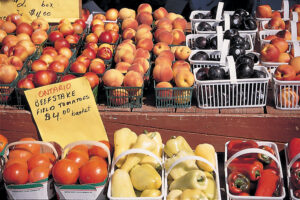
Historical buildings, flower pots and outdoor cafes line the sidewalks of Stratford. The 1898 designed Stratford City Hall dominates Market Square. In the midst of downtown, between Downie and Erie Streets there is a special oasis, a spot to stop under the trees and watch the world go by. Well-established specialty shops sell everything from fine china to Scottish tartans, clothing, books and west coast and native art. The Shakespearean Gardens located near the County Courthouse grow the myriads of plants that are mentioned in Shakespeare’s plays. A bust of the Bard resides in the rose garden, near flower-wreathed arbors and woven vines. Private homes and front-yard gardens make a walk in the heart of Stratford’s residential areas a horticultural treat. A double-decker bus tour can familiarize visitors with all the things to see and do.
Thanks to restaurants of every style and price range, Stratford has a reputation for good food. Many graduates of the renowned Stratford Chef’s School have opened their own establishments. Opportunities for multi-course dinners and fine dining are balanced with gourmet French fries and specialty icecreams. Elaborate dining rooms and bistros compete with sidewalk cafes, Basket lunches are available for picnics along the Avon River.
All the towns and villages on our southwestern Ontario adventure encourage RVers to stop and visit. In Stratford, large recreational vehicles can find parking at malls on the east side of town. A $7 taxi ride downtown is an option as parking a large RV in the city is difficult. The Stratford fairgrounds offer basic sites with hook-ups.
Whether this main roads to back roads adventure is taken as a day trip or a week’s trip, it will lead to a return visit to St. Jacobs and Stratford. The food, the countryside, the shopping, the theatre and the people guarantee it.
WHERE TO STAY
Green Acre Park
www.greenacrepark.com
Laurel Creek Conservation Area
www.grandriver.ca
Bingaman Park
https://bingemans.com
Sun Retreats Stratford
www.sunoutdoors.com/ontario/sun-retreats-stratford
Wildwood Conservation Area
(Stratford)
www.wildwoodconservationarea.ca
Country Gardens RV Park
1-866-224-0503
www.countrygardensrvpark.ca
For Further Information:
The Village of St. Jacobs
www.stjacobsvillage.com
St. Jacobs Farmer’s Market
www.stjacobsmarket.com
City of Stratford – The Municipality
www.stratford.ca


